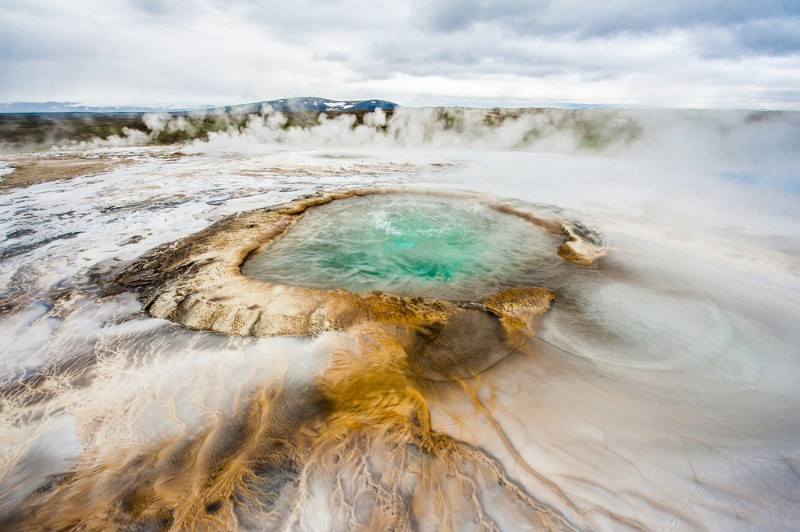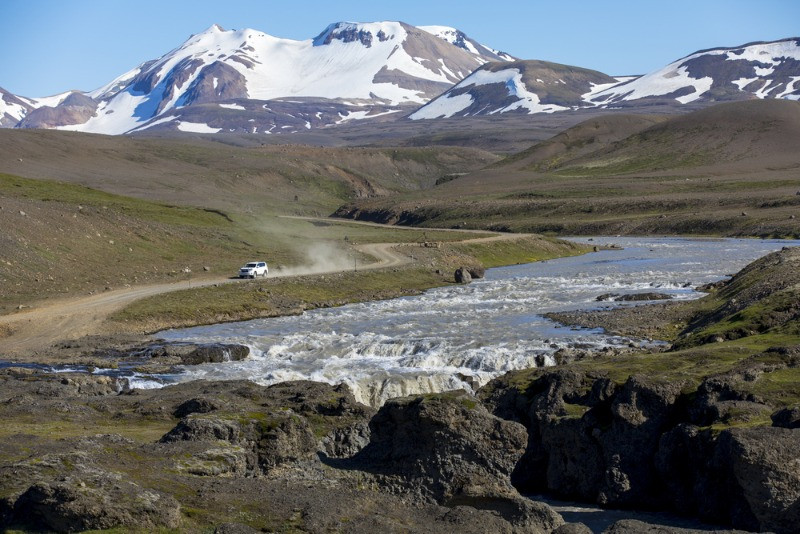Many visitors to Iceland embark on a trip around the ring road; this is a popular route and is widely advertised. Of course, on this route, you will encounter some incredible Icelandic wonders. But inside the ring road, there is a whole other world waiting to be explored: the highlands of Iceland. The interior of Iceland (the highlands) is almost completely unpopulated. You can access the highlands, but it’s not as simple as driving down the highway; restrictions are in place to ensure the safety of everyone venturing into the interior.
Kjölur Route, Iceland
One particularly famous highland route is the Kjölur Route, also known as Route F35 or Kjalvegur. It’s one of the only roads that pass all the way through the interior, so there is no need to turn around and come back the way you came, as is the case for many F roads. The Kjölur Route actually passes through a mountain range, weaving around some of the highest points in Iceland and between two glaciers: Langjökull and Hofsjökull. F35 is one of the longest roads in Iceland; without stopping, it will take about five hours to drive from start to finish. However, you will want to stop many times along the way.
The highlands can only be accessed via mountain roads, or F roads (F stands for fjall, which means mountain). These highland roads are gravel roads, and so for that reason, only 4x4 vehicles are permitted to drive on them. Keep this in mind when you rent a car; while renting a Jeep or a Land Rover in Iceland might cost you a bit more, a two-wheel-drive vehicle will not cut it on F roads. Not only is it gravel all the way; but on many F roads, there are also river crossings to contend with.
The speed must be kept down and great care must be taken on these routes, and they are not for the inexperienced or faint-hearted. Additionally, due to Iceland’s fairly extreme winters, the F roads are only accessible from June to September, and the exact opening dates depend on road conditions. Check that your route is open on http://www.road.is/ before leaving for a trip.
There is so much to see along the route; here are a few favorites:
Hveravellir Hot Spring on Kjölur Plateau, Iceland
Iceland contains many natural hot springs, and the interior is no exception. Hveravellir, located just north of the center of Iceland, has been known about for centuries. Take a break here and bathe in the steaming waters, but that’s not all you can do up there. On the Kjölur Plateau, a base camp has been set up, which offers two camping houses and a small restaurant.

Use this as your starting point from which to explore the surrounding area; there are some incredible hikes that pass through the Kjalhraun lava field. The road begins past Blönduós in the north, then finishes in the south of Iceland, near Haukadalur (or starts in the south and finishes in the north, that’s up to you). Even if you haven’t heard of Haukadalur, you’ll know what it is. It’s the famous geothermal area on the Golden Circle route, where the active geyser, Strokkur, is located. Before that, though, you pass the entrance to Gullfoss waterfall, another stop on the Golden Circle route.
Depending on how much time you have, it’s worth exploring some more of the southern parts of Iceland; you might as well complete the whole Golden Circle at the beginning or end of the Kjölur Route. This trip is best done over two or even three days, to make the most of your time in the highlands.
Safety on F Roads
It’s important to pay attention to the weather forecasts and only embark on this trip if the weather looks good. You can check the weather on the Icelandic Meteorological Office’s website. Even then, Iceland’s weather is famously unpredictable, so always be prepared for the worst. Bring warm, waterproof clothing just in case (Icelandic summers are not known for their warmth anyway). It’s best not to drive on F roads after heavy rainfall; if you do, those river crossings I mentioned earlier might be impassable.

Know that most car rental companies’ standard insurance doesn’t cover damage to the car due to gravel, which is why it’s so important to drive at a reasonable speed. And, as I mentioned before, while it may be tempting to take your car rental in Iceland up to the highlands, if it’s not a 4x4 then it’s best avoided. Only 4x4 vehicles could handle this drive anyway. And stick to the roads; off-road driving is illegal in Iceland.
Bring plenty of drinking water and snacks, because you’ll go long stretches without anywhere to buy supplies. And ensure that you have a full tank of gas before turning onto an F road. Once you leave Reykjavík the gas stations are fairly spread out, so a good rule to follow is to fill up whenever you reach half a tank and there is a station nearby.


 By
By


